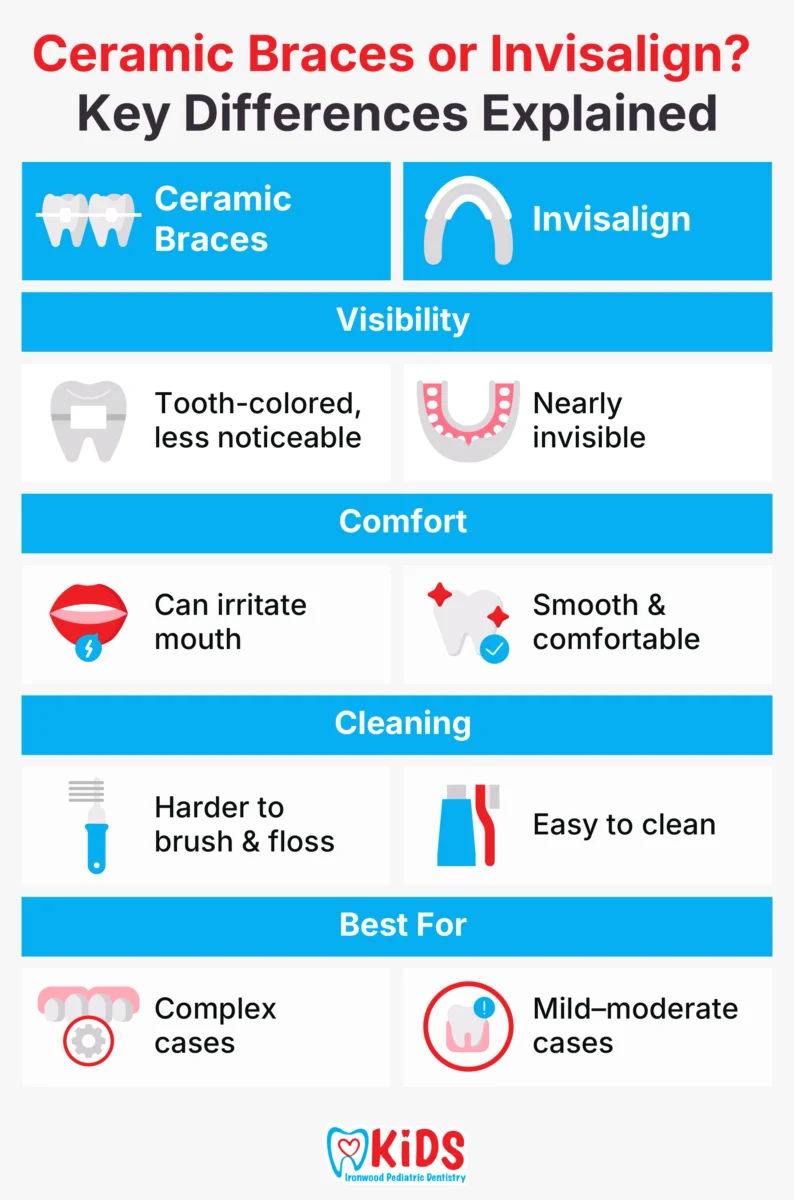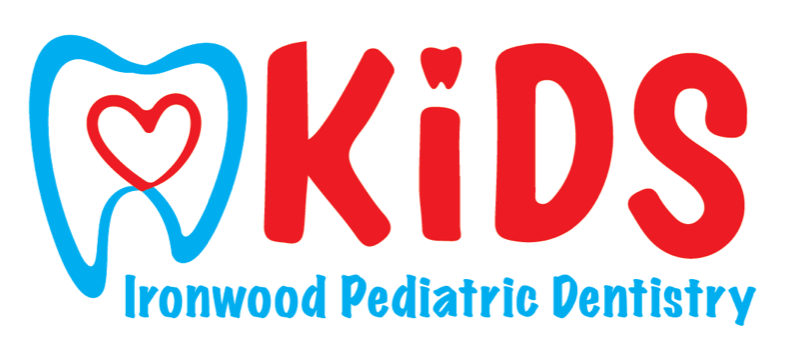Ceramic braces and Invisalign each have their advantages and disadvantages, which depend in part on what kind of treatment your child needs. In this post, we compare these two popular choices for low-visibility orthodontic treatment.
If you’re looking for the best orthodontic option for your child, please call Ironwood Pediatric Dentistry at (480) 422-4544 or contact us online.
Pros and Cons of Ceramic Braces
Ceramic braces are made of inorganic, nonmetallic materials that are typically hard and brittle, or, in some cases, they can be made of porcelain or plastic. Although they are not truly invisible braces, these materials can be tooth colored to match the surfaces of your child’s teeth, making them much less visible than traditional braces.
Ceramic braces work in the same way traditional braces do, using wires and elastics to exert steady pressure on misaligned teeth to move them into their new, ideal positions.
Advantages of Ceramic Braces
Some advantages of ceramic braces include:
- Reduced visibility: Like Invisalign, ceramic braces are less visible than traditional metal braces.
- Effective: ceramic braces are just as reliably effective as traditional braces.
Disadvantages of Ceramic Braces
A main consideration when using ceramic braces is that although they are less visible than metal braces, they are still more visible than Invisalign aligners. If near-invisibility is the most important thing to your child, ceramics cannot compare to Invisalign.
Other possible disadvantages of ceramic braces include:
- Not as comfortable: ceramics can be less comfortable to wear than clear aligners.
- Possible breakage: Because ceramic materials can be brittle, they can be subject to breakage in your child’s mouth.
- Dietary restrictions: Because ceramic braces are cemented in place and cannot be removed during treatment, your child will need to limit or avoid eating certain hard, sticky, crunchy, or chewy foods that can put stress on the ceramic brackets and cause possible breakage.
- Harder to keep clean: The combination of brackets, wires, and elastics can make it harder to keep teeth and braces clean compared to Invisalign aligners, which are removable.

Pros and Cons of Invisalign Aligners
Invisalign clear aligners are trays made of plastic. Treatment consists of multiple sets of customized removable trays. Your child wears each tray set for about two weeks before switching to the next set. Each tray set is designed to continue the gradual realignment process from the set before.
Advantages of Invisalign
The main advantage of Invisalign is that it is virtually invisible when worn. No other orthodontic treatment option can compare to Invisalign in terms of low visibility.
Aside from the low visibility factor, here are some other advantages of Invisalign:
- Removability: The ability to remove Invisalign aligners is significant in more than one way. It removes any dietary restrictions that otherwise apply to braces; it makes the aligners easy to clean; and it makes brushing and flossing teeth much easier compared to braces.
- Comfort: Invisalign aligners do not rely on brackets, arch wires, and elastics to apply pressure to teeth, which can make them easier to wear. It also means that your child does not need to worry about the possibility of a broken bracket or wire rubbing against the inside of his or her mouth until it can be replaced.
- Customizability: Invisalign aligner treatment uses computer-designed trays that specifically match your child’s unique orthodontic needs. This can also mean fewer required visits to the orthodontist during treatment compared to braces treatment.
- Possible shorter treatment length: In cases for which they are well suited, Invisalign may take less time to realize straighter teeth than braces.
Disadvantages of Invisalign
No orthodontic treatment choice is perfect for all cases. There are a few potential drawbacks to Invisalign. These include:
- Not suitable for all orthodontic needs: Invisalign treatment is well-suited for mild to moderate overcrowding, overbites and underbites, and spacing issues. Invisalign may not be the best choice in complex orthodontic cases for which braces are usually better suited.
Ceramic Braces vs Invisalign: Which Is Best for Your Child?
Both Invisalign clear aligners and ceramic braces are effective in treating many tooth misalignment and malocclusion issues in children. Both compare well to traditional metal braces in terms of reduced visibility.
Ultimately, the choice as to which is better for your child’s orthodontic needs comes down to a few key considerations, the most important of which is whether Invisalign will be as effective as braces in your child’s particular case. If they are, then Invisalign offers several significant advantages over braces, including minimal visibility, removability, comfort, ease of cleaning, no food restrictions, and possibly shorter treatment times.
In some cases, your orthodontist may recommend a combination of braces and Invisalign treatment to straighten your teeth.
One of our experienced orthodontists at Ironwood Pediatric Dentistry can help you make the best-informed decision about which treatment choice is best for your child. Call us at (480) 422-4544 or use our contact form.
